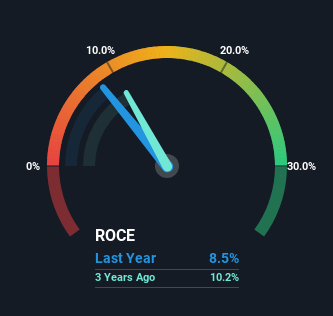Returns At Sany Heavy Equipment International Holdings (HKG:631) Appear To Be Weighed Down

What are the early trends we should look for to identify a stock that could multiply in value over the long term? Firstly, we'd want to identify a growing return on capital employed (ROCE) and then alongside that, an ever-increasing base of capital employed. Basically this means that a company has profitable initiatives that it can continue to reinvest in, which is a trait of a compounding machine. However, after briefly looking over the numbers, we don't think Sany Heavy Equipment International Holdings (HKG:631) has the makings of a multi-bagger going forward, but let's have a look at why that may be.
Understanding Return On Capital Employed (ROCE)
For those that aren't sure what ROCE is, it measures the amount of pre-tax profits a company can generate from the capital employed in its business. Analysts use this formula to calculate it for Sany Heavy Equipment International Holdings:
Return on Capital Employed = Earnings Before Interest and Tax (EBIT) ÷ (Total Assets - Current Liabilities)
0.085 = CN¥1.6b ÷ (CN¥35b - CN¥16b) (Based on the trailing twelve months to March 2024).
So, Sany Heavy Equipment International Holdings has an ROCE of 8.5%. On its own, that's a low figure but it's around the 9.1% average generated by the Machinery industry.
View our latest analysis for Sany Heavy Equipment International Holdings

In the above chart we have measured Sany Heavy Equipment International Holdings' prior ROCE against its prior performance, but the future is arguably more important. If you'd like to see what analysts are forecasting going forward, you should check out our free analyst report for Sany Heavy Equipment International Holdings .
What The Trend Of ROCE Can Tell Us
The returns on capital haven't changed much for Sany Heavy Equipment International Holdings in recent years. The company has consistently earned 8.5% for the last five years, and the capital employed within the business has risen 142% in that time. This poor ROCE doesn't inspire confidence right now, and with the increase in capital employed, it's evident that the business isn't deploying the funds into high return investments.
On a side note, Sany Heavy Equipment International Holdings' current liabilities are still rather high at 46% of total assets. This can bring about some risks because the company is basically operating with a rather large reliance on its suppliers or other sorts of short-term creditors. Ideally we'd like to see this reduce as that would mean fewer obligations bearing risks.
The Bottom Line On Sany Heavy Equipment International Holdings' ROCE
In summary, Sany Heavy Equipment International Holdings has simply been reinvesting capital and generating the same low rate of return as before. Although the market must be expecting these trends to improve because the stock has gained 75% over the last five years. However, unless these underlying trends turn more positive, we wouldn't get our hopes up too high.
Like most companies, Sany Heavy Equipment International Holdings does come with some risks, and we've found 1 warning sign that you should be aware of.
While Sany Heavy Equipment International Holdings isn't earning the highest return, check out this free list of companies that are earning high returns on equity with solid balance sheets.
New: Manage All Your Stock Portfolios in One Place
We've created the ultimate portfolio companion for stock investors, and it's free.
• Connect an unlimited number of Portfolios and see your total in one currency
• Be alerted to new Warning Signs or Risks via email or mobile
• Track the Fair Value of your stocks
Have feedback on this article? Concerned about the content? Get in touch with us directly. Alternatively, email editorial-team (at) simplywallst.com.
This article by Simply Wall St is general in nature. We provide commentary based on historical data and analyst forecasts only using an unbiased methodology and our articles are not intended to be financial advice. It does not constitute a recommendation to buy or sell any stock, and does not take account of your objectives, or your financial situation. We aim to bring you long-term focused analysis driven by fundamental data. Note that our analysis may not factor in the latest price-sensitive company announcements or qualitative material. Simply Wall St has no position in any stocks mentioned.
Have feedback on this article? Concerned about the content? Get in touch with us directly. Alternatively, email editorial-team@simplywallst.com
About SEHK:631
Sany Heavy Equipment International Holdings
Manufactures and sells mining and logistics equipment, electricity, power station project products, petroleum and new energy manufacturing equipment, spare parts, and related services.
Excellent balance sheet with reasonable growth potential.
Similar Companies
Market Insights
Community Narratives



